The Lazy Summer Kerchief was inspired by a trip I took... 13 years ago! It combines the simple bandana-inspired styling of a traditional kerchief, with the fantastic addition of a hair band rather than ties. This makes it easy on and off - perfect for lazy summer days!
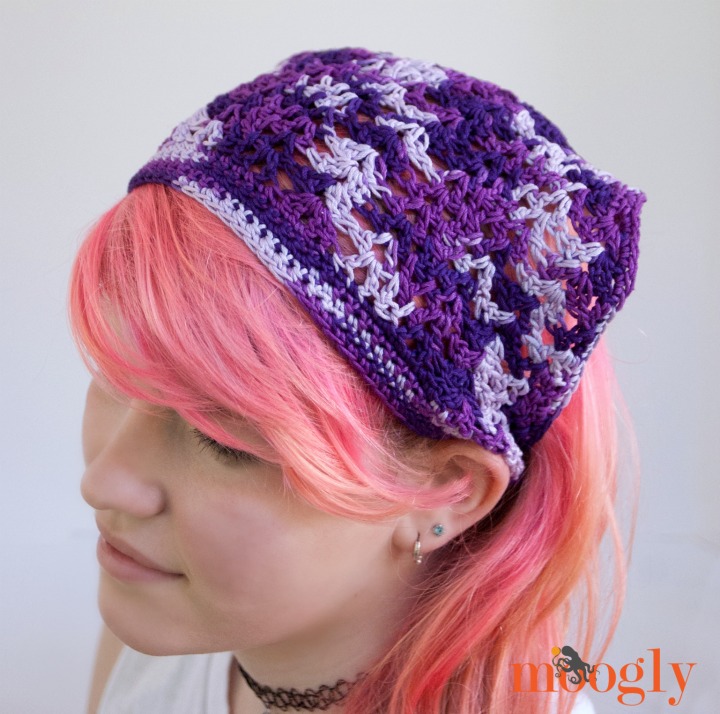 Disclaimer: This post includes affiliate links.
Disclaimer: This post includes affiliate links.
Do you mind a little story first? When my daughter was just 6 months old, we got on a plane in Chicago! We flew all the way to Warsaw, Poland, to visit her grandfather. It was a wonderful trip, and my first time outside North America (hers too of course!).
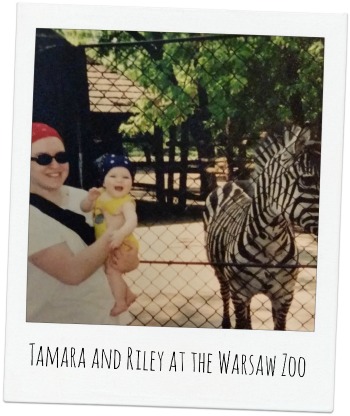 And apparently, we looked the part. Or more specifically, my daughter did. While standing and people-watching in the Old Town Marketplace, we were approached by two ladies. In simple, careful English, they asked if they could take a picture of the "beautiful Polish baby." We had to laugh and explain that we were American... And it turns out the ladies were from Chicago too! They still wanted the picture though, and we were happy to oblige.
And apparently, we looked the part. Or more specifically, my daughter did. While standing and people-watching in the Old Town Marketplace, we were approached by two ladies. In simple, careful English, they asked if they could take a picture of the "beautiful Polish baby." We had to laugh and explain that we were American... And it turns out the ladies were from Chicago too! They still wanted the picture though, and we were happy to oblige.
What caught their attention? I had bandanas that I used as a kerchief to keep her little head protected. (And my own - it was a big heat wave!) I had only just learned to crochet, and my skills weren't "hat worthy" yet. But if they had been, I'd like to think I would've made her one of these!
At least I can make a Lazy Summer Kerchief for her to wear today! And with 4 sizes, you can make one for anyone at any age!

Lazy Summer Kerchief
Add this pattern to your Ravelry Queue and Favorites
- US - H, 5.0mm hook
- 70-100 yds Sport/5 ply yarn (Omega Sinfonia used: 100% cotton; 218 yds/199 m; 3.52 oz/100 g; Colorway #847)
- 1 hair band/elastic band
- Gauge: 16 sts x 22 rows = 4 inches in sc
- Sizes: Baby (16-18" head); Toddler/Child (18-20" head); Child/Teen (20-22" head); Adult (22-24" head)
Special Stitches:
- wdc2tog (wide double crochet two together decrease) – dc2tog in between the posts on either side of the dc2tog of the previous round
- v st (V stitch) – [dc, ch 1, dc] in the same stitch
- double v st (double V stitch) – [2 dc, ch 1, 2dc] in the same stitch
NOTE: V-sts are all worked in the v-sts below, and the double v-sts are worked into the double v-sts below
BABY SIZE LAZY SUMMER KERCHIEF INSTRUCTIONS
Row 1: Ch 9, dc in the 5th ch from the hook (first v st made), dc2tog over the next 3 ch (skip center ch), v st in the last ch; turn.
Row 2: Ch 3 (counts as first dc), v st in next ch sp, wdc2tog, v st in ch sp, dc in top of ch 3; turn.
Row 3: Ch 4, dc in 1st st (first v st made), v st in next ch sp, wdc2tog. Vs st in next ch sp, v st in top of ch 3; turn.
Row 4: Ch 3, [dc, ch 1, 2 dc] in next ch sp, v st in next ch sp, wdc2tog, v st in next ch sp, [2 dc, ch 1, dc] in next ch sp, dc in top of ch 3; turn.
Row 5: Ch 3, double v st in next ch sp, v st in next ch sp, wdc2tog, v st in next ch sp, double v st in next ch sp, dc in top of ch 3; turn.
Row 6: Ch 4, dc in 1st st, double v st in next ch sp, v st in next ch sp, wdc2tog, v st in next ch sp, double v st in next ch sp, v st in top of ch 3; turn.
Row 7: Ch 3, v st in next ch sp, double v st in next ch sp, v st in next ch sp, wdc2tog, v st in next ch sp, double v st in next ch sp, v st in next ch sp, dc in top of ch 3; turn.
Row 8: Ch 3, dc in next st, v st in ch sp, double v st in next ch sp, v st in next ch sp, wdc2tog, v st in next ch sp, double v st in next ch sp, v st in next ch sp, dc in next st, dc in top of ch 3; turn.
Row 9: Ch 3, dc2tog working between first 2 sts of previous row and top of 3rd st of previous row, v st in next ch sp, double v st in next ch sp, v st in next ch sp, wdc2tog, v st in next ch sp, double v st in next ch sp, v st in next ch sp, dc2tog in top of next st and between last 2 sts, dc in top of ch 3; turn.
Row 10: Ch 4, dc in 1st st, wdc2tog, v st in next ch sp, double v st in next ch sp, v st in next ch sp, wdc2tog, v st in next ch sp, double v st in next ch sp, v st in next ch sp, wdc2tog, v st in top of ch 3; turn.
Row 11: Ch 3, *v st in next ch sp, wdc2tog, v st in next ch sp,** double v st in next ch sp; rep from * across, finishing last repeat at **, then dc in the top of the ch 3; turn.
Row 12: Ch 4, dc in 1st st *v st in next ch sp, wdc2tog, v st in next ch sp,** double v st in next ch sp; rep from * across, finishing last repeat at **, then v st in the top of the ch 3; turn.
Row 13: Ch 3, [dc, ch 1, 2 dc] in next ch sp, *v st in next ch sp, wdc2tog, v st in next ch sp,** double v st in next ch sp; rep from * across, finishing last repeat at **, then [2 dc, ch 1, dc] in last ch sp, dc in top of ch 3; turn.
Row 14: Ch 3, double v st in next ch sp, *v st in next ch sp, wdc2tog, v st in next ch sp, double v st in next ch sp; rep from * across, then dc in top of ch 3; turn.
Row 15: Ch 4, dc in 1st st, double v st in next ch sp, *v st in next ch sp, wdc2tog, v st in next ch sp, double v st in next ch sp; rep from * across, then v st in top of ch 3; turn.
Row 16: Ch 3, *v st in next ch sp, double v in next ch sp, v st in next ch sp,** wdc2tog; rep from * across, finishing last repeat at **, then dc in the top of the ch 3; turn.
Row 17: Ch 3, dc in next st, *v st in ch sp, double v st in next ch sp, v st in next ch sp,** wdc2tog; rep from * across, finishing last repeat at **, then dc in the next st, dc in the top of the ch 3; turn.
Row 18: Ch 1, sc in each st and ch sp across; turn. (51 sts)
NOTE:
The remaining rows form the band that goes around the head and will be attached to the hair band. Please try this on before cutting the yarn. Hair bands do not come in standard sizes or elasticity. So you may need to adjust the number of stitches to create the perfect fit. Err on the tighter side to account for stretching of both the band and the yarn.
Row 19: Ch 5, skip the ch closest to the hook, sc in the remaining 4 chs, sc in each st across, extend the row with 4 FSC; turn. (59 sts) (CLICK HERE for a tutorial on extending a row with FSC)
Row 20 - 21: Ch 1, sc in each st across; turn. (59 sts)
Row 22 (edging and attaching the hair band): Ch 1, sc in each st across, turn to sc across the ends of Rows 22-19, enclosing the hair band in each st; turn again to sc along the other side of the band and along the two sides of the scarf; at the next end of the band, sc across the ends of Rows 19-22, enclosing the other side of the hair band; break yarn and finish off (but not before you try it on!).

TODDLER/CHILD SIZE LAZY SUMMER KERCHIEF INSTRUCTIONS:
Row 1: Ch 9, dc in the 5th ch from the hook (first v st made), dc2tog over the next 3 ch (skip center ch), v st in the last ch; turn.
Row 2: Ch 3 (counts as first dc), v st in next ch sp, wdc2tog, v st in ch sp, dc in top of ch 3; turn.
Row 3: Ch 4, dc in 1st st (first v st made), v st in next ch sp, wdc2tog. Vs st in next ch sp, v st in top of ch 3; turn.
Row 4: Ch 3, [dc, ch 1, 2 dc] in next ch sp, v st in next ch sp, wdc2tog, v st in next ch sp, [2 dc, ch 1, dc] in next ch sp, dc in top of ch 3; turn.
Row 5: Ch 3, double v st in next ch sp, v st in next ch sp, wdc2tog, v st in next ch sp, double v st in next ch sp, dc in top of ch 3; turn.
Row 6: Ch 4, dc in 1st st, double v st in next ch sp, v st in next ch sp, wdc2tog, v st in next ch sp, double v st in next ch sp, v st in top of ch 3; turn.
Row 7: Ch 3, v st in next ch sp, double v st in next ch sp, v st in next ch sp, wdc2tog, v st in next ch sp, double v st in next ch sp, v st in next ch sp, dc in top of ch 3; turn.
Row 8: Ch 3, dc in next st, v st in ch sp, double v st in next ch sp, v st in next ch sp, wdc2tog, v st in next ch sp, double v st in next ch sp, v st in next ch sp, dc in next st, dc in top of ch 3; turn.
Row 9: Ch 3, dc2tog working between first 2 sts of previous row and top of 3rd st of previous row, v st in next ch sp, double v st in next ch sp, v st in next ch sp, wdc2tog, v st in next ch sp, double v st in next ch sp, v st in next ch sp, dc2tog in top of next st and between last 2 sts, dc in top of ch 3; turn.
Row 10: Ch 4, dc in 1st st, wdc2tog, v st in next ch sp, double v st in next ch sp, v st in next ch sp, wdc2tog, v st in next ch sp, double v st in next ch sp, v st in next ch sp, wdc2tog, v st in top of ch 3; turn.
Row 11: Ch 3, *v st in next ch sp, wdc2tog, v st in next ch sp,** double v st in next ch sp; rep from * across, finishing last repeat at **, then dc in the top of the ch 3; turn.
Row 12: Ch 4, dc in 1st st *v st in next ch sp, wdc2tog, v st in next ch sp,** double v st in next ch sp; rep from * across, finishing last repeat at **, then v st in the top of the ch 3; turn.
Row 13: Ch 3, [dc, ch 1, 2 dc] in next ch sp, *v st in next ch sp, wdc2tog, v st in next ch sp,** double v st in next ch sp; rep from * across, finishing last repeat at **, then [2 dc, ch 1, dc] in last ch sp, dc in top of ch 3; turn.
Row 14: Ch 3, double v st in next ch sp, *v st in next ch sp, wdc2tog, v st in next ch sp, double v st in next ch sp; rep from * across, then dc in top of ch 3; turn.
Row 15: Ch 4, dc in 1st st, double v st in next ch sp, *v st in next ch sp, wdc2tog, v st in next ch sp, double v st in next ch sp; rep from * across, then v st in top of ch 3; turn.
Row 16: Ch 3, *v st in next ch sp, double v in next ch sp, v st in next ch sp,** wdc2tog; rep from * across, finishing last repeat at **, then dc in the top of the ch 3; turn.
Row 17: Ch 3, dc in next st, *v st in ch sp, double v st in next ch sp, v st in next ch sp,** wdc2tog; rep from * across, finishing last repeat at **, then dc in the next st, dc in the top of the ch 3; turn.
Row 18: Ch 3, dc2tog working between first 2 sts of previous row and top of 3rd st of previous row, *v st in next ch sp, double v st in next ch sp, v st in next ch sp,** wdc2tog; rep from * across, finishing last repeat at **, dc2tog in top of next st and between last 2 sts, dc in top of ch 3; turn.
Row 19: Ch 4, dc in 1st st, wdc2tog, *v st in next ch sp, double v st in next ch sp, v st in next ch sp, wdc2tog; rep from * across, then v st in top of ch 3; turn.
Row 20: Ch 3, *v st in next ch sp, wdc2tog, v st in next ch sp,** double v st in next ch sp; rep from * across, finishing last repeat at **, then dc in the top of the ch 3; turn.
Row 21: Ch 1, sc in each st and ch sp across; turn. (57 sts)
NOTE:
The remaining rows form the band that goes around the head and will be attached to the hair band. Please try this on before cutting the yarn. Hair bands do not come in standard sizes or elasticity. So you may need to adjust the number of stitches to create the perfect fit. Err on the tighter side to account for stretching of both the band and the yarn.
Row 22: Ch 5, skip the ch closest to the hook, sc in the remaining 4 chs, sc in each st across, extend the row with 4 FSC; turn. (65 sts) (CLICK HERE for a tutorial on extending a row with FSC)
Row 23 - 24: Ch 1, sc in each st across; turn. (65 sts)
Row 25 (edging and attaching the hair band): Ch 1, sc in each st across, turn to sc across the ends of Rows 25-22, enclosing the hair band in each st; turn again to sc along the other side of the band and along the two sides of the scarf; at the next end of the band, sc across the ends of Rows 22-25, enclosing the other side of the hair band; break yarn and finish off (but not before you try it on!).
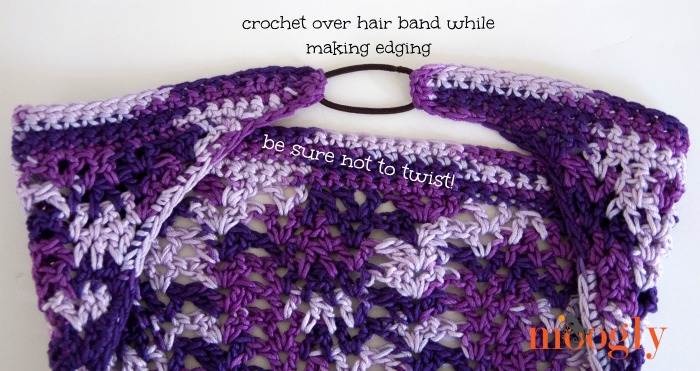
CHILD/TEEN SIZE LAZY SUMMER KERCHIEF INSTRUCTIONS:
Row 1: Ch 9, dc in the 5th ch from the hook (first v st made), dc2tog over the next 3 ch (skip center ch), v st in the last ch; turn.
Row 2: Ch 3 (counts as first dc), v st in next ch sp, wdc2tog, v st in ch sp, dc in top of ch 3; turn.
Row 3: Ch 4, dc in 1st st (first v st made), v st in next ch sp, wdc2tog. Vs st in next ch sp, v st in top of ch 3; turn.
Row 4: Ch 3, [dc, ch 1, 2 dc] in next ch sp, v st in next ch sp, wdc2tog, v st in next ch sp, [2 dc, ch 1, dc] in next ch sp, dc in top of ch 3; turn.
Row 5: Ch 3, double v st in next ch sp, v st in next ch sp, wdc2tog, v st in next ch sp, double v st in next ch sp, dc in top of ch 3; turn.
Row 6: Ch 4, dc in 1st st, double v st in next ch sp, v st in next ch sp, wdc2tog, v st in next ch sp, double v st in next ch sp, v st in top of ch 3; turn.
Row 7: Ch 3, v st in next ch sp, double v st in next ch sp, v st in next ch sp, wdc2tog, v st in next ch sp, double v st in next ch sp, v st in next ch sp, dc in top of ch 3; turn.
Row 8: Ch 3, dc in next st, v st in ch sp, double v st in next ch sp, v st in next ch sp, wdc2tog, v st in next ch sp, double v st in next ch sp, v st in next ch sp, dc in next st, dc in top of ch 3; turn.
Row 9: Ch 3, dc2tog working between first 2 sts of previous row and top of 3rd st of previous row, v st in next ch sp, double v st in next ch sp, v st in next ch sp, wdc2tog, v st in next ch sp, double v st in next ch sp, v st in next ch sp, dc2tog in top of next st and between last 2 sts, dc in top of ch 3; turn.
Row 10: Ch 4, dc in 1st st, wdc2tog, v st in next ch sp, double v st in next ch sp, v st in next ch sp, wdc2tog, v st in next ch sp, double v st in next ch sp, v st in next ch sp, wdc2tog, v st in top of ch 3; turn.
Row 11: Ch 3, *v st in next ch sp, wdc2tog, v st in next ch sp,** double v st in next ch sp; rep from * across, finishing last repeat at **, then dc in the top of the ch 3; turn.
Row 12: Ch 4, dc in 1st st *v st in next ch sp, wdc2tog, v st in next ch sp,** double v st in next ch sp; rep from * across, finishing last repeat at **, then v st in the top of the ch 3; turn.
Row 13: Ch 3, [dc, ch 1, 2 dc] in next ch sp, *v st in next ch sp, wdc2tog, v st in next ch sp,** double v st in next ch sp; rep from * across, finishing last repeat at **, then [2 dc, ch 1, dc] in last ch sp, dc in top of ch 3; turn.
Row 14: Ch 3, double v st in next ch sp, *v st in next ch sp, wdc2tog, v st in next ch sp, double v st in next ch sp; rep from * across, then dc in top of ch 3; turn.
Row 15: Ch 4, dc in 1st st, double v st in next ch sp, *v st in next ch sp, wdc2tog, v st in next ch sp, double v st in next ch sp; rep from * across, then v st in top of ch 3; turn.
Row 16: Ch 3, *v st in next ch sp, double v in next ch sp, v st in next ch sp,** wdc2tog; rep from * across, finishing last repeat at **, then dc in the top of the ch 3; turn.
Row 17: Ch 3, dc in next st, *v st in ch sp, double v st in next ch sp, v st in next ch sp,** wdc2tog; rep from * across, finishing last repeat at **, then dc in the next st, dc in the top of the ch 3; turn.
Row 18: Ch 3, dc2tog working between first 2 sts of previous row and top of 3rd st of previous row, *v st in next ch sp, double v st in next ch sp, v st in next ch sp,** wdc2tog; rep from * across, finishing last repeat at **, dc2tog in top of next st and between last 2 sts, dc in top of ch 3; turn.
Row 19: Ch 4, dc in 1st st, wdc2tog, *v st in next ch sp, double v st in next ch sp, v st in next ch sp, wdc2tog; rep from * across, then v st in top of ch 3; turn.
Row 20: Ch 3, *v st in next ch sp, wdc2tog, v st in next ch sp,** double v st in next ch sp; rep from * across, finishing last repeat at **, then dc in the top of the ch 3; turn.
Row 21: Ch 4, dc in 1st st, v st in next ch sp, *v st in next ch sp, wdc2tog, v st in next ch sp,** double v st in next ch sp; rep from * across, finishing last repeat at **, then v st in the top of the ch 3; turn.
Row 22: Ch 1, sc in each st and ch sp across; turn. (61 sts)
NOTE:
The remaining rows form the band that goes around the head and will be attached to the hair band. Please try this on before cutting the yarn. Hair bands do not come in standard sizes or elasticity. So you may need to adjust the number of stitches to create the perfect fit. Err on the tighter side to account for stretching of both the band and the yarn.
Row 23: Ch 5, skip the ch closest to the hook, sc in the remaining 4 chs, sc in each st across, extend the row with 4 FSC; turn. (69 sts) (CLICK HERE for a tutorial on extending a row with FSC)
Row 24 - 25: Ch 1, sc in each st across; turn. (69 sts)
Row 26 (edging and attaching the hair band): Ch 1, sc in each st across, turn to sc across the ends of Rows 26-23, enclosing the hair band in each st; turn again to sc along the other side of the band and along the two sides of the scarf; at the next end of the band, sc across the ends of Rows 23-26, enclosing the other side of the hair band; break yarn and finish off (but not before you try it on!).
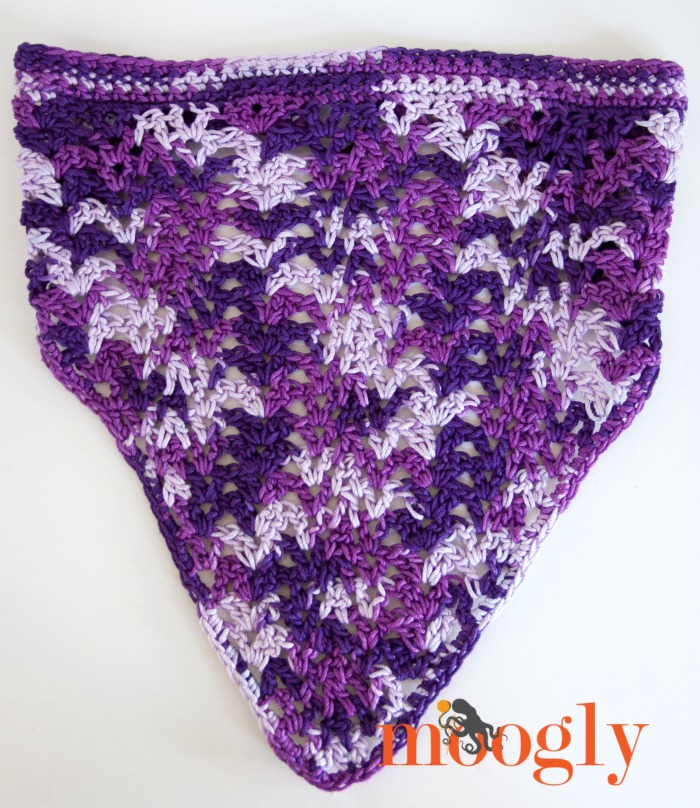
ADULT SIZE LAZY SUMMER KERCHIEF INSTRUCTIONS:
Row 1: Ch 9, dc in the 5th ch from the hook (first v st made), dc2tog over the next 3 ch (skip center ch), v st in the last ch; turn.
Row 2: Ch 3 (counts as first dc), v st in next ch sp, wdc2tog, v st in ch sp, dc in top of ch 3; turn.
Row 3: Ch 4, dc in 1st st (first v st made), v st in next ch sp, wdc2tog. Vs st in next ch sp, v st in top of ch 3; turn.
Row 4: Ch 3, [dc, ch 1, 2 dc] in next ch sp, v st in next ch sp, wdc2tog, v st in next ch sp, [2 dc, ch 1, dc] in next ch sp, dc in top of ch 3; turn.
Row 5: Ch 3, double v st in next ch sp, v st in next ch sp, wdc2tog, v st in next ch sp, double v st in next ch sp, dc in top of ch 3; turn.
Row 6: Ch 4, dc in 1st st, double v st in next ch sp, v st in next ch sp, wdc2tog, v st in next ch sp, double v st in next ch sp, v st in top of ch 3; turn.
Row 7: Ch 3, v st in next ch sp, double v st in next ch sp, v st in next ch sp, wdc2tog, v st in next ch sp, double v st in next ch sp, v st in next ch sp, dc in top of ch 3; turn.
Row 8: Ch 3, dc in next st, v st in ch sp, double v st in next ch sp, v st in next ch sp, wdc2tog, v st in next ch sp, double v st in next ch sp, v st in next ch sp, dc in next st, dc in top of ch 3; turn.
Row 9: Ch 3, dc2tog working between first 2 sts of previous row and top of 3rd st of previous row, v st in next ch sp, double v st in next ch sp, v st in next ch sp, wdc2tog, v st in next ch sp, double v st in next ch sp, v st in next ch sp, dc2tog in top of next st and between last 2 sts, dc in top of ch 3; turn.
Row 10: Ch 4, dc in 1st st, wdc2tog, v st in next ch sp, double v st in next ch sp, v st in next ch sp, wdc2tog, v st in next ch sp, double v st in next ch sp, v st in next ch sp, wdc2tog, v st in top of ch 3; turn.
Row 11: Ch 3, *v st in next ch sp, wdc2tog, v st in next ch sp,** double v st in next ch sp; rep from * across, finishing last repeat at **, then dc in the top of the ch 3; turn.
Row 12: Ch 4, dc in 1st st *v st in next ch sp, wdc2tog, v st in next ch sp,** double v st in next ch sp; rep from * across, finishing last repeat at **, then v st in the top of the ch 3; turn.
Row 13: Ch 3, [dc, ch 1, 2 dc] in next ch sp, *v st in next ch sp, wdc2tog, v st in next ch sp,** double v st in next ch sp; rep from * across, finishing last repeat at **, then [2 dc, ch 1, dc] in last ch sp, dc in top of ch 3; turn.
Row 14: Ch 3, double v st in next ch sp, *v st in next ch sp, wdc2tog, v st in next ch sp, double v st in next ch sp; rep from * across, then dc in top of ch 3; turn.
Row 15: Ch 4, dc in 1st st, double v st in next ch sp, *v st in next ch sp, wdc2tog, v st in next ch sp, double v st in next ch sp; rep from * across, then v st in top of ch 3; turn.
Row 16: Ch 3, *v st in next ch sp, double v in next ch sp, v st in next ch sp,** wdc2tog; rep from * across, finishing last repeat at **, then dc in the top of the ch 3; turn.
Row 17: Ch 3, dc in next st, *v st in ch sp, double v st in next ch sp, v st in next ch sp,** wdc2tog; rep from * across, finishing last repeat at **, then dc in the next st, dc in the top of the ch 3; turn.
Row 18: Ch 3, dc2tog working between first 2 sts of previous row and top of 3rd st of previous row, *v st in next ch sp, double v st in next ch sp, v st in next ch sp,** wdc2tog; rep from * across, finishing last repeat at **, dc2tog in top of next st and between last 2 sts, dc in top of ch 3; turn.
Row 19: Ch 4, dc in 1st st, wdc2tog, *v st in next ch sp, double v st in next ch sp, v st in next ch sp, wdc2tog; rep from * across, then v st in top of ch 3; turn.
Row 20: Ch 3, *v st in next ch sp, wdc2tog, v st in next ch sp,** double v st in next ch sp; rep from * across, finishing last repeat at **, then dc in the top of the ch 3; turn.
Row 21: Ch 4, dc in 1st st, v st in next ch sp, *v st in next ch sp, wdc2tog, v st in next ch sp,** double v st in next ch sp; rep from * across, finishing last repeat at **, then v st in the top of the ch 3; turn.
Row 22: Ch 3, [dc, ch 1, 2 dc] in next ch sp, *v st in next ch sp, wdc2tog, v st in next ch sp,** double v st in next ch sp; rep from * across, finishing last repeat at **, then [2 dc, ch 1, dc] in last ch sp, dc in top of ch 3; turn.
Row 23: Ch 1, sc in each st and ch sp across; turn. (65 sts)
NOTE:
The remaining rows form the band that goes around the head and will be attached to the hair band. Please try this on before cutting the yarn. Hair bands do not come in standard sizes or elasticity. So you may need to adjust the number of stitches to create the perfect fit. Err on the tighter side to account for stretching of both the band and the yarn.
Row 24: Ch 5, skip the ch closest to the hook, sc in the remaining 4 chs, sc in each st across, extend the row with 4 FSC; turn. (73 sts) (CLICK HERE for a tutorial on extending a row with FSC)
Row 25 - 26: Ch 1, sc in each st across; turn. (73 sts)
Row 27 (edging and attaching the hair band): Ch 1, sc in each st across, turn to sc across the ends of Rows 27-24, enclosing the hair band in each st; turn again to sc along the other side of the band and along the two sides of the scarf; at the next end of the band, sc across the ends of Rows 24-27, enclosing the other side of the hair band; break yarn and finish off (but not before you try it on!).
I hope you enjoy the free crochet Lazy Summer Kerchief pattern! If you share a photo on social media, please tag @mooglyblog or #mooglyblog so I can see it too! ♥
The Fine Print
Written pattern copyright Tamara Kelly 2015, all rights reserved. Please do not reprint or repost this pattern. But please do link to this page to share this pattern with others. If you wish to make items for sale from this pattern, please visit the About page for details.


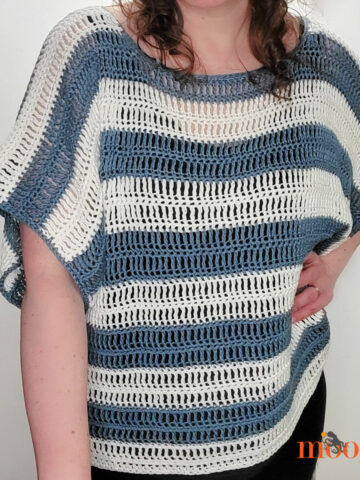
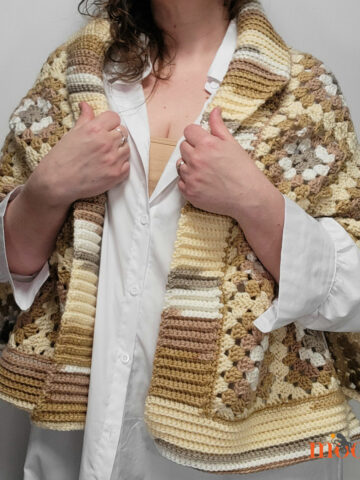
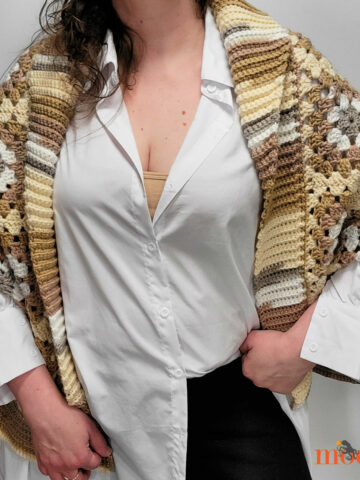
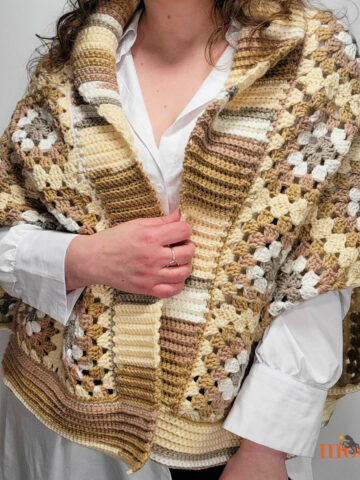

Martha Aldridge
Perfect timing on this pattern -- I've been thinking of making a kerchief, but I hadn't gotten around to figuring out how. Now I don't have to! And I love the idea of using a ponytail holder instead of making strings to tie!
Susan Kasmiskie
Thank you for sharing. I like this scarf a lot!!!
Tamara Kelly
😀 Thank you so much Susan!
Erika
I am not understanding the wdc2tog....... Do you have a video of this stitch yet?......I have 4 girls and 3 of them have hair to their butts or longer and this would be amazing to help control it.
Tamara Kelly
Hi Erika! It's the same stitch pattern as the Vintage Wobbly Afghan (with some futzing at the edges to create an increase). This video demonstrates the stitch https://www.mooglyblog.com/vintage-wobble-afghan-tutorial/
Erika
thank you so much
Gwen
I have recently thought of making some of these but didn't have a pattern and don't know how to design. Thank you so much for this cute, cute pattern! I am going to make one for each of my mission girls at church, my nieces, and grand nieces! Gotta go start my crochet!! God bless. 🙂
Tamara Kelly
😀 Thank you Gwen!
Marlene
now THATS spooky, we are on vacantion and visited Poland, esp Warschau..while wearing my crocheted shawl every day..now we are in Sweden and tomorro over The Bridge to Denmark and then heading home ...I am on a market within 2 weeks, fundraising for the KiKa, KidsCancerFree and will make some of these amazing bandana.s....hope people will love them and maybe an idea for children who have had chemo..(like I had myself several times) thnx a lot, from Sweden (at this moment) with love,
Marlene
Tamara Kelly
<3 What an amazing coincidence! I hope you are enjoying your trip - and thank you for your crochet work Marlene!
Gwen
works up nicely until row 21. (on the child/teen and Adult)
Row 21: Ch 4, dc in 1st st, double v st in next ch sp, (*v st in next ch sp), wdc2tog, v st in next ch sp,** double v st in next ch sp; rep from * across, finishing last repeat at **, then v st in the top of the ch 3; turn.
(*v st in next ch sp) there is no spot to do this.
so I just did ch4. dc in 1st st, v stitch in next ch sp, wdc2tog and continued on as in previous rows. when I tried to do the double v without the v following it looked very wrong
Gwen
by doing that I did come up with the 61 ss on the next row =)
Tamara Kelly
Thank you Gwen!
Kat
i'm not exactly a beginner but i'm not an expert. i was trying the adult size and i honestly became lost on row one. i know how to do the dc2tog... but you say to dc in the 5th chain from the hook which leaves 4 chains... and then you say to dc2tog in the next 3 chains... i thought dc2tog only take up 2 chains. if i'm wrong please clarify. thanks.... just trying to understand this pattern.
Tamara Kelly
Hi Kat! The skipped 4 chains count as a dc and ch 1 - so with that first dc in the 5th ch, you create a sort of V stitch. Then the dc2tog over 3 chains, it's worked as a normal dc2tog, but you skip a chain between the "legs". Does that help?
pik
Hi! Just wanted to say that it would really help to know that the v-sts are all worked in the v-sts below, and the double v-sts are worked into the double v-sts below. Since it isn't specified which ch-1 sp to work into, it would only take one miscount to mess up the entire row and every row thereafter - with no idea what went wrong! This drove me crazy til i figured it out, and I've been crocheting for over 20 years. Knowing that one thing makes the entire pattern make sense. I love how it's turning out now though!
Tamara Kelly
Thank you for your feedback, I'm glad it's going along well now!
Becka
What size thread did u use?
Tamara Kelly
Sinfonia is a Sport, 5 ply, 12 wpi, 2:Fine yarn.
Becka
Thank u.looks like a cute pattern 😄
Khia
Hi, I love this pattern but Im having a hard time understanding it. Especially with Row 1. Would it be too much to ask for a small tutorial video on how to start this pattern?
Tamara Kelly
Hi Khia! I would be happy to make one, but it might take a little time. Would a chart help?
Khia
I don’t mind the wait! I can try the chart but I’ve never used a chart but I’m down to try that while waiting for the video.
Tamara Kelly
I'll send one to your email! 🙂
Khia
Thank you! I can’t wait to get home and start this now!